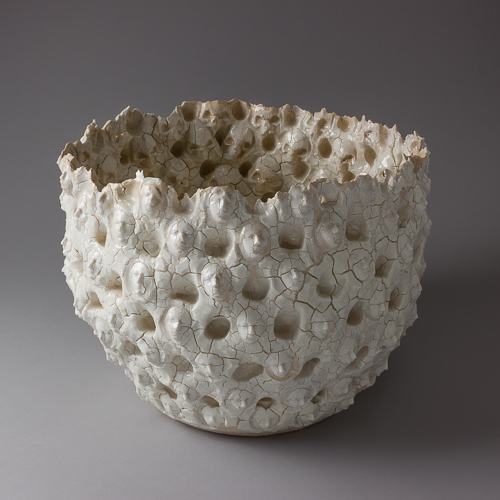Porcelain is that most tough and translucent ceramic that yet seems most delicate and fragile. The Contemporary Ceramics Centre’s new exhibition Porcelain3 brings together the work of three relatively young ceramicists who are creating new perceptions of porcelain in their own special ways.
I say ceramicists, I could also say artists or craftspeople. There are endless and inconclusive arguments about what is art, what is craft and what is applied art when it comes to ceramics. Some of the works here have a practical application but most if not all have been made primarily for their aesthetic value. The quality of the build is the overriding criterion for the Craft Potters Association of which all three are members.

The most dramatic exhibits on show are the work of Anja Lubach, a German based in London. Her hallmark is the use of religious figurines, small porcelain faces she calls Madonnas, which she imprints into the clay when it is still wet. In her “Melting Pots” series, she dribbles thick porcelain slip down her pots, in either direction, to create highly evocative textures. In a new work, Vessel with stretched paper porcelain surface, she has gone a step further.
She appears to have made the piece in two layers. Having created a pot, she has covered it in another layer of porcelain slip that she has mixed with a paper pulp. When it has dried out the difference in shrinkage leads to a deliberately cracked surface. This makes for a wonderful tension between solidity and fragility and has pushed the boundaries of porcelain making. The interior impression of the Madonnas are rendered skull-like, adding an element of the macabre.

Katharina Klug is another German based in the UK, in Cambridge in fact. German potters are renowned for their apprenticeship scheme that’s strongly skill-based leading to high technical ability. Klug’s work is aimed at contemporary interiors and is much simpler in design.
Inspired by the colour and shape of ancient Korean pottery, her signature are the lines and simple patterns she hand draws, inspired by the geometry she sees in the world around her, anything from telephone lines to stripes on cloth. She uses wax pastels to produce a simple resist technique. As in life, the lines are imperfect, not mechanically made, which makes them unique and gives them life under her signature dark matt glaze. A recent development is her use of colours for her interiors. I particularly found the blood-red very striking.

I also loved the wonderful glaze finish which highlights the work of Jo Davies whose wheel-thrown and hand-built porcelain objects have been snapped up by collectors around the world. Her pieces hold a wet look, as if they’ve just come off the wheel, and, although monochrome, give off different colours from the reflections around them.
Davies has a Masters degree from the Royal College of Art and works at the communal Chocolate Factory studio in Stoke Newington. For the past decade, she has specialised in porcelain enjoying its elastic and fluid properties. Every so often she marks her pieces with spontaneous indentations and impressions before they go to the kiln. It gives them that human touch.
All the works are for sale at accessible prices. The exhibition is showing at the Contemporary Ceramics Centre at 63 Great Russel Street, London WC1B 3BF, directly opposite the British Museum, until 10 March 2018.
The images are courtesy of the Centre.

Leave a comment